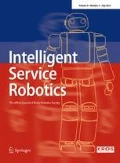Abstract
Spatial variance reduction of microbot systems through ensemble control, i.e., using a global control input, is a challenging task. In this paper, we propose to use a sequence of primary motion maneuvers called motion primitives to perform spatial variance reduction. We extract these primitives from the principal directions of the optimal control trajectories. The primitives efficiently discretize the input space and reduce the dimension of the search space significantly. These enable us to exploit lightweight and adaptable search algorithms like \(A^{*}\) for the task of fast sub-optimal input primitive sequence generation. Furthermore, we propose a primitive-based receding horizon motion planner (PB-RHMP) to increase robustness to process noise and model uncertainty. We validate the proposed methods with several simulated case studies.













Similar content being viewed by others
References
Abbott JJ, Nagy Z, Beyeler F, Nelson BJ (2007) Robotics in the small, part i: microbotics. IEEE Robotics Autom Magaz 14(2):92–103
Becker A, Habibi G, Werfel J, Rubenstein M, McLurkin J (2013) Massive uniform manipulation: Controlling large populations of simple robots with a common input signal. In: IEEE/RSJ International Conference on Intelligent Robots and Systems 520–527. https://doi.org/10.1109/IROS.2013.6696401
Cohen BJ, Chitta S, Likhachev M (2010) Search-based planning for manipulation with motion primitives. In: IEEE International Conference on Robotics and Automation 2902–2908. https://doi.org/10.1109/ROBOT.2010.5509685
Diller E, Floyd S, Pawashe C, Sitti M (2012) Control of multiple heterogeneous magnetic microrobots in two dimensions on nonspecialized surfaces. IEEE Trans. Robotics 28(1):172–182. https://doi.org/10.1109/TRO.2011.2170330
Ferreira A, Cassier C, Hirai S (2004) Automatic microassembly system assisted by vision servoing and virtual reality. IEEE/ASME Trans. Mechatron. 9(2):321–333
Gauthier M, Regnier S (2011) Robotic Microassembly. John Wiley & Sons
Hansen EA, Zhou R (2007) Anytime heuristic search. J Art Intell Res 28:267–297. https://doi.org/10.1613/jair.2096
Hart P, Nilsson N, Raphael B (1968) A formal basis for the heuristic determination of minimum cost paths. IEEE Trans Syst Sci Cybern 4(2):100–107. https://doi.org/10.1109/tssc.1968.300136
Julius AA, Sakar MS, Steager E, Cheang UK, Kim M, Kumar V, Pappas GJ (2009) Harnessing bacterial power in microscale actuation. In: IEEE International Conference on Robotics and Automation, pp. 1004–1009 . 10.1109/ROBOT.2009.5152631
Kharboutly M, Gauthier M, Chaillet N (2009) Modeling the trajectory of a microparticle in a dielectrophoresis device. J Appl Phys 106(11):114312
Kim DH, Cheang UK, Kőhidai L, Byun D, Kim MJ (2010) Artificial magnetotactic motion control of tetrahymena pyriformis using ferromagnetic nanoparticles: a tool for fabrication of microbiorobots. Appl Phys Lett 10(1063):3497275
Kim PSS, Becker AT, Ou Y, Kim DH, Julius AA, Kim M (2017) Magnetic swarm control of microorganisms. In: Microbiorobotics, second edition edn., pp. 221–243. Elsevier, Boston https://doi.org/10.1016/B978-0-32-342993-1.00018-5
Kulić D, Ott C, Lee D, Ishikawa J, Nakamura Y (2012) Incremental learning of full body motion primitives and their sequencing through human motion observation. The Int J Robotics Res 31(3):330–345. https://doi.org/10.1177/0278364911426178
Lewis F, Vrabie D, Syrmos V (2012) Optimal control of discrete-time systems, chap. 2, pp. 19–109. John Wiley & Sons, Ltd . https://doi.org/10.1002/9781118122631.ch2
Liew LA, Bright V, Dunn M, Daily J, Raj R.: Development of sicn ceramic thermal actuators. Technical Digest. IEEE International Conference on Micro Electro-Mechanical Systems 10.1109/memsys.2002.984340
Nelson BJ, Kaliakatsos IK, Abbott JJ (2010) Microrobots for minimally invasive medicine. Ann Rev Biomed Eng 12(1):55–85. https://doi.org/10.1146/annurev-bioeng-010510-103409
Ou Y, Kim DH, Kim P, Kim MJ, Julius AA (2012) Motion control of magnetized tetrahymena pyriformis cells by a magnetic field with model predictive control. The Int J Robotics Res 32(1):129–140. https://doi.org/10.1177/0278364912464669
Pearson K (1901) On lines and planes of closest fit to systems of points in space. The London, Edinburgh, and Dublin Philosophical Magazine and Journal of Science 2(11):559–572. https://doi.org/10.1080/14786440109462720
Pivtoraiko M, Kelly A (2011) Kinodynamic motion planning with state lattice motion primitives. In: 2011 IEEE/RSJ International Conference on Intelligent Robots and Systems, pp. 2172–2179 . 10.1109/IROS.2011.6094900
Qiu F, Zhang L, Tottori S, Marquardt K, Krawczyk K, Franco-Obregón A, Nelson BJ (2012) Bio-inspired microrobots. Mater Today 15(10):463
Sakar MS, Steager EB, Kim DH, Kim MJ, Pappas GJ, Kumar V (2010) Single cell manipulation using ferromagnetic composite microtransporters. Appl Phys Lett 96:043705. https://doi.org/10.1063/1.3293457
Shahrokhi S, Lin L, Ertel C, Wan M, Becker AT (2018) Steering a swarm of particles using global inputs and swarm statistics. IEEE Trans Robotics 34(1):207–219. https://doi.org/10.1109/tro.2017.2769094
Steager EB, Sakar MS, Kim DH, Kumar V, Pappas GJ, Kim MJ (2011) Electrokinetic and optical control of bacterial microrobots. J Micromech Microeng 21(3):035001. https://doi.org/10.1088/0960-1317/21/3/035001
Stulp F, Theodorou EA, Schaal S (2012) Reinforcement learning with sequences of motion primitives for robust manipulation. IEEE Trans Robotics 28(6):1360–1370. https://doi.org/10.1109/TRO.2012.2210294
Suter M, Zhang L, Siringil EC, Peters C, Luehmann T, Ergeneman O, Peyer KE, Nelson BJ, Hierold C (2013) Superparamagnetic microrobots: fabrication by two-photon polymerization and biocompatibility. Biomed Microdev 15(6):997–1003
Truper T, Kortschack A, Jahnisch M, Hulsen H, Fatikow S (2004) Transporting cells with mobile microrobots. In: IEE Proceedings-Nanobiotechnology 151:145–150
Xu T, Yu J, Yan X, Choi H, Zhang L (2015) Magnetic actuation based motion control for microrobots: an overview. Micromachines 6(9):1346–1364
Zilberstein S (1996) Using anytime algorithms in intelligent systems. AI Mag 17(3):73–83
Funding
This work was supported by National Science Foundation (CMMI#1712096, CMMI#1761060, and CNS#1618369).
Author information
Authors and Affiliations
Corresponding author
Additional information
Publisher's Note
Springer Nature remains neutral with regard to jurisdictional claims in published maps and institutional affiliations.
Rights and permissions
About this article
Cite this article
Thelasingha, N., Julius, A.A. & Kim, M.J. Ensemble control of spatial variance of microbot systems through sequencing of motion primitives from optimal control trajectories. Intel Serv Robotics 15, 215–230 (2022). https://doi.org/10.1007/s11370-022-00421-x
Received:
Accepted:
Published:
Issue Date:
DOI: https://doi.org/10.1007/s11370-022-00421-x




